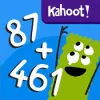
Digital Citizenship Week is October 20–24!
Join teachers worldwide to promote a healthy, positive approach to media and tech.
Take a look inside 5 images
Kahoot! Big Numbers: DragonBox
Pros: A very tactile game with intrinsic motivation and extensive addition/subtraction practice.
Cons: Sometimes it's more game than learning, and vigorous tapping can cause students to accidentally exchange resources.
Bottom Line: Hopelessly addictive addition/subtraction app keeps students learning and learning.
For students who need extra practice adding and subtracting large numbers, Kahoot! Big Numbers: DragonBox will help them. Since the game is the focus with math being the mechanic that propels it forward, students can focus more on how to play and less on the math itself. The drive to reach their in-game goals will push them to work hard on the arithmetic, as being fluent in the necessary addition and subtraction helps them make progress faster. The settings of the game allow for the narrator to speak in many languages, so it can be used with ELLs as well. The game includes spots for up to four profiles, making it work well for small classroom use.
If students get frustrated, encourage them to first work to get as many trees producing apples as possible, since that's the origin of most of the currency. With more trees producing apples, their store of apples will grow faster, allowing students to convert apples into other currencies faster to unlock new areas of the game. The game has one tricky aspect of concern for over-enthusiastic students: If kids tap the screen indiscriminately, they may accidentally spend some currency in an area different from the one they were saving to spend it in. There is no "Are you sure?" screen that pops up when something is traded or a Noom is paid.
The purpose of Kahoot! Big Numbers: DragonBox is for students to practice their addition and subtraction skills with large numbers, but it is packaged in a goal-oriented game where students build a world for creatures called Nooms. Students can explore and play, collect resources, exchange for other resources, and build houses for the Nooms, all while learning how to manipulate the big numbers through addition, subtraction, and regrouping. With many hours of gameplay and no reading required, the app engages students in a series of enticements to collect and trade for enough resources to unlock new areas. There are six worlds to explore, 10 resources to collect and trade, and four Noom houses to build.
There are few to no actual instructions in the game, but they aren't really necessary. Students collect apples, then add them to their collection. As they collect more apples, they add the number collected to their previous total. When they have at least 10, the grouping and regrouping begins. Students can then spend collected (and added) apples on diamonds in the mine (using subtraction), which will unlock new areas, currencies, and challenges. After a while, the game starts having students add and subtract using regular numerals, instead of just grouping items. As students play, their goals continue to evolve, but the ultimate goal, of unlocking everything, building houses, and decorating them, remains.
Though Kahoot! Big Numbers: DragonBox may seem to be more game than learning, addition and subtraction of big numbers is integral to the gameplay. It's impossible to move forward in the game without adding and subtracting (with the necessary regrouping) because you can't use your gathered currencies until they are added to your previous total. Students may not want to linger over the arithmetic and thus will learn to do it quickly, internalizing the lessons and becoming fluent. It's an extremely tactile game, but younger kids may get overexcited and tap too vigorously to collect apples or catch bees.
Beyond the obvious arithmetic included in the game, this app also teaches students to set goals and convert currencies. Though there are some general long-term goals in the game, students set their own priorities on what is important to them, such as unlocking all the areas or building and decorating houses. Exchange rates vary in number and type, too, depending on how far students are in the game. There are many options here with no wrong answers, and there's always something to do, so students will keep coming back for more.













